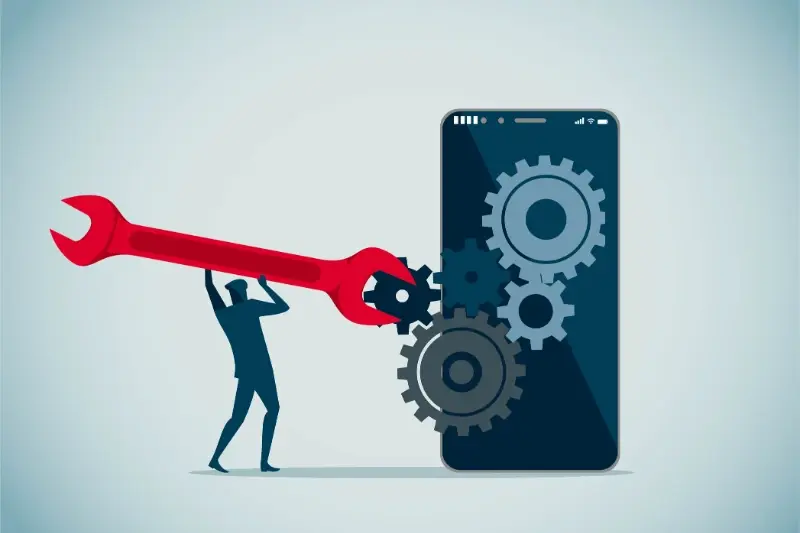The Hidden Costs Of Cheap App Development
You've got a brilliant app idea, check. You're shopping around for developers, check. Three quotes land in your inbox—one for £25,000, another for £50,000, and a third for £8,000. Which one do you choose? If you're like most people, that £8,000 quote is looking pretty tempting right about now. After all, an app is an app, right?
Wrong. Dead wrong actually, and this misconception has cost countless businesses their reputation, their customers, and sometimes their entire future. The cheap app development risks lurking beneath those attractive price tags are rarely discussed upfront, but they're always waiting to surface later when it's too late to do anything about them.
The bitter taste of poor quality remains long after the sweet taste of low price is forgotten
Over the years, I've watched businesses make this exact mistake time and time again. They choose the cheapest option thinking they're being clever with their budget, only to discover that low cost app development problems don't just appear—they multiply. What starts as a simple cost-saving decision quickly becomes a expensive lesson in why app development quality vs price isn't just about numbers on a spreadsheet. It's about understanding that when it comes to building something that represents your brand and serves your customers, cutting corners today means paying the price tomorrow.
Why Quality Costs More Than You Think
Here's something that might surprise you—building a proper mobile app takes a lot more work than most people realise. I've had countless conversations with business owners who think app development should cost the same as a basic website. But the reality is quite different.
Quality app development involves multiple specialists working together for weeks or months. You need designers who understand mobile interfaces, developers who can write clean code, testers who spot problems before users do, and project managers who keep everything on track. Each of these people brings years of experience to your project.
What Goes Into Professional App Development
- User research and planning phase
- Custom design and user interface creation
- Backend system architecture and database setup
- Thorough testing across different devices and scenarios
- App store submission and approval process
- Post-launch monitoring and support
Cheap developers often skip these steps or rush through them. They might use templates instead of custom designs, skip proper testing, or ignore backend security. The result? An app that looks fine on the surface but falls apart when real users start using it.
When you pay for quality, you're not just buying code—you're investing in expertise, proper processes, and peace of mind. The extra cost upfront saves you from much bigger expenses later on, and understanding what your app developer needs from you can help ensure you're both on the same page about expectations and requirements.
When Your App Crashes More Than It Runs
Picture this: you've just launched your shiny new app and within hours the one-star reviews start flooding in. "Crashes every time I open it!" "Completely unusable!" "Waste of space!" This isn't just embarrassing—it's a business disaster waiting to happen. When you choose cheap app development, you're gambling with your app's stability, and frankly, the house always wins.
I've seen apps that crash so frequently they make users question whether their phone is broken. The problem is that budget developers often skip proper testing phases, use outdated coding practices, or simply don't have the experience to handle complex functionality. They might build something that works on their test device but falls apart on different operating systems, screen sizes, or hardware configurations.
Common Stability Issues with Budget Development
- Memory leaks that slow down devices
- Poor error handling that causes instant crashes
- Incompatibility with different phone models
- Slow loading times that frustrate users
- Features that simply don't work as promised
The brutal truth? Users will delete a buggy app faster than you can say "technical difficulties." App stores are packed with alternatives, so why would anyone tolerate an app that doesn't work properly? Your cheap development savings quickly evaporate when you're haemorrhaging users and damaging your brand reputation.
Before hiring any development team, ask to see examples of their apps running live in app stores and check the user reviews for stability complaints. It's also worth understanding what are the main reasons mobile apps fail so you can avoid these pitfalls entirely.
The Real Price of Poor User Experience
Here's something that might shock you—88% of users won't return to an app after a bad experience. That's not just a number; that's your potential customers walking away and never coming back. When you choose cheap app development, you're gambling with something that costs far more than money: your reputation.
Poor user experience doesn't just mean confusing buttons or slow loading times (though those are painful enough). It means frustrated customers who can't complete purchases, giving up halfway through signing up, or worse—leaving angry reviews that other potential users will see. I've watched businesses lose thousands of pounds in revenue because their bargain-basement app made simple tasks feel impossible.
The Ripple Effect of Bad Design
Think about it this way: every person who has a terrible experience with your app tells their friends, family, and probably their social media followers too. One bad user experience can quickly become ten, twenty, or even hundreds of people who now associate your brand with frustration. The cost of acquiring new customers keeps going up whilst your cheap app keeps pushing them away—it's a losing battle that gets more expensive every month.
This is why understanding how app development starts and ends with your customer is so crucial—when you lose sight of the user experience, you lose everything else that matters.
Security Risks That Could Destroy Your Business
Here's something that keeps me awake at night—cheap app development often means cutting corners on security. I've seen businesses get completely wiped out because their budget developer didn't implement proper data protection. We're talking about customer credit card details, personal information, and business secrets all sitting there like an unlocked front door.
The scary part? Most business owners don't even know their app is vulnerable until it's too late. Low-cost developers might skip security audits, use outdated encryption methods, or worse—store sensitive data in plain text. They'll tell you everything's fine because the app looks good on the surface.
Real Consequences of Poor Security
When hackers get into your system, you're not just losing data. You're facing legal action, regulatory fines, and customers who'll never trust you again. The average data breach costs businesses hundreds of thousands of pounds—money that could have been saved by investing in proper security from day one.
One client told me their cheap app development disaster cost them £300,000 in legal fees alone after customer data was compromised
Quality app development includes security testing, encrypted data storage, and regular vulnerability assessments. Yes, it costs more upfront, but it's nothing compared to rebuilding your entire business reputation after a security breach destroys everything you've worked for.
Maintenance Nightmares and Technical Debt
Technical debt is like borrowing money—except instead of cash, you're borrowing time and quality. When developers cut corners to meet tight budgets, they create problems that pile up over time. What seems like a quick fix today becomes a massive headache tomorrow.
I've seen apps where adding a simple new feature takes weeks instead of days because the original code is such a mess. The developers who built it cheap took shortcuts that made sense at the time but created a tangled web of problems. Every time you want to change something, you risk breaking three other things.
The Ongoing Cost Spiral
Here's what typically happens with poorly built apps:
- Bug fixes take much longer than they should
- Adding new features becomes increasingly expensive
- System updates break existing functionality
- Performance issues get worse over time
- Security patches become complicated to implement
The worst part? These problems compound. What starts as a slightly messy codebase becomes completely unmaintainable within a year or two. I've had clients come to us saying it would be cheaper to rebuild their entire app from scratch than to keep fixing the original version. That's not the kind of surprise anyone wants in their budget planning.
Learning what developers can learn from the top app development companies shows you the standards and practices that prevent these maintenance nightmares in the first place.
Hidden Costs of Fixing What Should Have Been Done Right
Here's where cheap app development really starts to hurt your wallet—when you have to pay twice for the same work. I've seen businesses spend more money fixing poorly built apps than they would have spent on proper development in the first place. It's like buying a house with dodgy wiring; you end up ripping out walls and starting again.
The problem with fixing bad code isn't just the time it takes. Your developers have to understand someone else's messy work first, which can take weeks. Then they need to untangle the problems without breaking the bits that actually work. Sometimes the cheapest option becomes starting from scratch—meaning you've wasted every penny from your original budget.
What makes this worse is that you're losing money whilst the fixes happen. Your app might be down, users are getting frustrated, and potential customers are going to your competitors instead. The revenue you're missing out on often costs more than the repairs themselves.
Always ask to see examples of an agency's code quality and testing processes before signing any contract. A good development team will be proud to show you their standards.
The harsh reality? Most businesses that choose the cheapest option end up spending 2-3 times more than if they'd invested in quality development from the start. That's not even counting the stress and lost opportunities along the way.
Marketing Challenges When Your App Doesn't Work Properly
Picture this: you've spent months planning your marketing campaign, invested in beautiful screenshots, crafted the perfect app store description, and launched with fanfare. Then the reviews start rolling in—one star after one star, all complaining about crashes, slow loading times, and broken features. Your marketing budget is now working against you, driving more people to discover just how poor your app really is.
When your app doesn't work properly, every marketing pound you spend becomes a liability rather than an asset. Social media campaigns that should build excitement instead generate complaints; influencer partnerships backfire when the app crashes during their demonstration; and your carefully planned PR launch becomes a disaster story that spreads faster than any positive coverage ever could.
The Ripple Effect of Poor Performance
Bad apps don't just fail quietly—they fail loudly and publicly. Here's what happens to your marketing efforts when quality isn't there:
- App store rankings plummet as negative reviews accumulate
- Social media mentions become overwhelmingly negative
- Word-of-mouth marketing works against you instead of for you
- Customer acquisition costs skyrocket as fewer people convert
- Paid advertising becomes less effective due to poor app store ratings
The cruel irony is that fixing these marketing challenges often costs more than building the app properly would have in the first place. You're not just paying to repair code—you're paying to rebuild trust, and that's far more expensive.
Even small details matter enormously when it comes to user perception, which is why savvy developers focus on what makes the difference between so-so apps and stellar apps—it's these finishing touches that separate professional development from budget shortcuts.
Conclusion
After eight years in this business, I've seen the same story play out countless times—someone chooses the cheapest option thinking they're being smart with their budget, only to end up spending three times more fixing the mess later. The truth is, cheap app development risks aren't just theoretical problems you read about online; they're very real issues that can sink your business before it even gets started.
When you're weighing up app development quality vs price, think about what you're actually buying. You're not just purchasing code—you're investing in your business's future. A poorly built app doesn't just cost you money to fix; it costs you customers, credibility, and countless sleepless nights worrying about security breaches or crashes during peak usage.
The low cost app development problems we've covered aren't meant to scare you away from building an app. They're meant to help you make an informed decision. Quality development might cost more upfront, but it saves you from the hidden expenses that come with cutting corners. Your app is often the first impression customers have of your business—make sure it's a good one. Sometimes paying a bit more now saves you from paying a lot more later.
Share this
Subscribe To Our Blog
You May Also Like
These Related Stories

No-Code vs. Custom Development: The Honest Comparison

The Hidden Truth About App Maintenance (and Why It Matters More Than Development)





